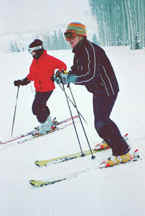
Women learn deep powder, no stress
By Kari J. Bodnarchuk, Globe Correspondent, 2/1/2004
THE CANYONS, Utah - It was time for a ski lesson. My technique hadn't improved in 15 years. My goal on each run was to get to the bottom in one piece, then maybe break for hot chocolate. My equipment was antiquated.

[Photo:
Kari J. Bodnarchuk]
Heidi
Voelker (right), three-time Olympian and former U.S. ski team member,
gives tips to skiers during a women's clinic at Deer Valley in Utah.
|
I was never going to be an Olympic-caliber skier, but at least I could learn from one. Clinics,
camps, and lessons are available at resorts across the country, offering ski or snowboard instruction from world-class athletes. Former Olympians, US ski and snowboard team members, and world champions offer instruction for people of all levels, whether you're a beginner, have hit a plateau, or want to sharpen your racing skills.
Last winter, I took two women's ski clinics, at Deer Valley and The Canyons in Utah, where I learned from some of the best female skiers in the world.
My instructors included Heidi Voelker, who competed in three Olympics, spent 12 years on the US ski team, has six top-10 World Cup finishes, and has been Deer Valley's "Ambassador of Skiing" since 1997, and Holly Flanders, a two-time Olympian, two-time national downhill champion, and three-time World Cup downhill champ, who leads three-day women's workshops at The Canyons resort, a few miles from Deer Valley.
"Having all women takes away the stress of trying to compete," said Voelker. "People try to improve with each run, but not be better than one another, so it really works. Plus, we tend to trust another woman when she says, 'You can do it.' " The popularity of these clinics has skyrocketed over the last several years, and resorts rarely need to publicize their events. The Deer Valley and Canyons workshops draw 30 to 40 participants each time. However, groups are kept small, about five students per instructor, so the classes don't lose their intimacy.
Participants typically range in age from their 20s to 70s, but the majority fall between 35 and 55. The women in my group at Deer Valley were in their upper 20s to mid-60s, and came from as far away as Martha's Vineyard and Los Angeles, even overseas. Some people find the idea of shredding the slopes with Olympic-caliber or professional skiers a little daunting.
"When people hear I'm going to be in the group, they freak out," said Voelker, who has a street named after her in Park City, Utah, home of the 2002 Winter Olympics and where she lives. "They think I'm going to come in and whip them into shape. We try to push you so you get better, but we want you to have a good experience, too."
These accomplished instructors weren't what concerned me: The powder did. I learned how to "carve" not "swoosh" on New England slopes, and the idea of deep snow was baffling, even intimidating. Luckily, Flanders and Voelker grew up in New England as well -- in New Hampshire and Massachusetts, respectively -- so they knew what it was like to transition from icy packed powder to fluff.
In Flanders's clinic, my group of intermediates was paired with Rebekah Abrams, a former ski racer who grew up in Massachusetts, in high school was ranked in the top 15 nationally, and now does "extreme skiing," based on technical ability not speed.
We spent several hours weaving our way down trails with Abrams, while Flanders jumped from group to group giving pointers and helping hone techniques.
"You want to keep an athletic stance -- back slightly rounded, knees bent, and arms out, like you're driving a bus or hugging a tree," she said. She's been running these workshops for 15 years, since The Canyons opened, and knows how to help skiers progress.
"Three days gives people enough time to get over a hurdle," Flanders said. "Day one, you get lots of techniques; day two, you feel like you've lost all your skills; day three, it all comes together."
During the workshops, skiers are videotaped on the slopes and these videos are analyzed later, a great technique for learning what you're doing right and where you can improve. Instructors also discuss proper ski equipment.
"Women often end up with hand-me-downs," said Abrams, "but it's essential to have good gear. We have a lower center of gravity and wider hips, so we turn differently and need skis that respond properly and work with us."
Our last day, we followed Voelker and Abrams on a little adventure: Our rate of descent doubled and then we were off the trail in knee-deep powder, dodging blue spruce and aspens. I was more concerned about avoiding the thick and unforgiving trees than carving a sweet turn.
We had one more steep, deep, powdery pitch, and I talked myself down it, repeating some of Voelker's tips as I descended: "Float on the powder. Anticipate. Be aggressive. Put pressure on your shins."
In the end, it was no longer about just getting down the mountain in one piece. It was, instead, fun -- and lots of it.
Kari Bodnarchuk is a freelance writer who lives in Boston.
© Copyright 2004 Globe Newspaper Company.
